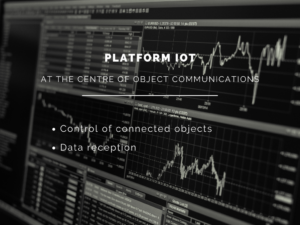A real control tower, an IoT platform allows you to control a fleet of connected objects on a granular level. Before choosing the type of IoT platform best suited to your needs, it is necessary to understand how the infrastructure
A real control tower, an IoT platform allows you to control a fleet of connected objects on a granular level. Before choosing the type of IoT platform best suited to your needs, it is necessary to understand how the infrastructure

A real control tower, an IoT platform allows you to control a fleet of connected objects on a granular level.
Before choosing the type of IoT platform best suited to your needs, it is necessary to understand how the infrastructure that connects the devices and their data to the networks works.
In its simplest form, an IoT platform is the element that centralises the communications of connected objects.
The IoT platform can thus be imagined as a control tower that connects a fleet of thousands of objects scattered around the world.
IoT platforms are cloud solutions capable of interfacing with communicating devices.
Such a platform is usually composed of a set of IoT application software distributed on a set of servers, coupled with generic pre-existing components (database and message routers).
This set exposes, on the one hand, interfaces dedicated to the communication with the connected objects and, on the other hand, graphical user interfaces (web) and programmatic interfaces (API) dedicated to third-party systems.

The specificity of IoT platforms lies in their ability to interface with communicating equipment. We have just seen this.
Let’s go further.
Communication between objects involves the use of protocols.
There are a multitude of protocols with different dialogues, each with its own use cases and operational constraints, such as the internet protocols MQTT or HTTP, or radio technologies such as LoRa or Sigfox.
Two main areas of functions can be fulfilled by an IoT platform:
The business functions are specific to each project context and cover specific uses and needs, linked to the exercise of a business. They are the reason why the connected solution is implemented.
In most cases, these functions are based on the collection and processing of information measured by the equipment deployed in the field.
For example :
For instance, to detect with low latency the occurrence of a failure and immediately notify operators.
On the other hand, this data can be accumulated and processed en masse for more statistical analysis (e.g. global performance reporting of a complex system; behaviour modelling via machine learning/IA).
Less often, business functions rely on the remote activation of systems:
By bringing a connected function to objects, it becomes necessary to ensure that this new communicating dimension works properly.
This is what we mean by “technical functions”.
The technical functions will therefore concern the “basic” operations common to all IoT platforms and specific to connectivity.
In order to guarantee the proper functioning of the fleet of devices, the IoT platform must be able to monitor the status of each device to ensure data feedback. In addition, it can also carry out the operations necessary for the smooth functioning of the objects connected to it.
The technical role of the IoT platform may be as follows:
To make these 2 families of IoT platform functions more concrete, here is a practical example.
Before the arrival of IoT platforms, GDF was forced to send technicians on-site to find a malfunction in the gas network. Having connected measurement equipment now allows them to monitor the gas distribution network remotely.
In this case, the business functions are: detecting gas leaks from the measurements provided by the sensors, while the IoT-related monitoring consists of ensuring that all the sensors are in proper working order.
Now that you are familiar with the use of an IoT platform, it’s time to make your selection from the solutions available.
The term IoT platform covers a variety of technical solutions. In fact, this sector is so new that each player offers a unique solution, with its own approach.
Here are the different approaches you may encounter and the associated risks/limitations that we advise you to check before making your choice:
The designers of connected objects such as gateways who sell them in series have a very hardware-oriented approach.
What is the risk of this approach?
They are not very focused on business functions and sometimes not very open to competing hardware. Therefore, sometimes their IoT platforms can only communicate with their own equipment, which limits their functions.
Network players often design IoT platforms using specific communication protocols.
What is the limit of this solution?
The risk is to end up with limited communication. And thus exclude objects that work with other communication protocols.
Sigfox is a good example illustrating this limitation. It is a platform that does not allow communication with objects using other protocols.
To know which platform to choose for your project, read our IoT platform comparison.
Infrastructures such as Amazon Web Services, Microsoft Azure, Samsung Artik, Google Cloud Platform, IBM Watson IoT or OVH have the advantage of not being tied to a particular network or hardware. It is therefore in their interest to choose relatively open or standard protocols to reach the maximum number of customers. They are the most present and also the most influential players: by forming partnerships with hardware manufacturers, they make themselves indispensable.
As a matter of fact, even if you don’t choose their IoT platform, it often happens that the chosen solution is installed by these cloud providers, who also tend to keep prices down.
As their name suggests, these players offer solutions tailored to a particular business.
For example, companies specialising in building management know how to manage air conditioning, heating and lighting systems. With the rise of the IoT, their management platforms have naturally evolved into IoT platforms.
There are many such platforms: agriculture, logistics, cold chain, health, to name a few.
Finally, players such as Rtone, or other integrators, know how to develop specific customised solutions.
The IoT platform is then architected on the basis of your business needs while benefiting from the reuse of principles or modules proven on previous projects.
The Rtone approach has the following advantages
This is what we have thought of with the Rtower solution – a solution that is both standardised, scalable and free.
As you have seen in this article, the IoT platform solutions available on the market cover very different realities. It’s will not be suitable for all projects.
The choice of your IoT platform, therefore, depends on your project, your connected objects and your uses.
To get a clear view of all these offers, we advise that you rely on the expertise of a connected solutions developer experienced in Cloud solutions.
If you would like to discuss this, please contact us.
by Charly Hamy, CTO Cloud & Mobile
Un peu de lecture
Des articles, des podcasts, des webinars… et surtout des conseils pratiques ! En bref, une collection de ressources pour mener à bien votre projet.